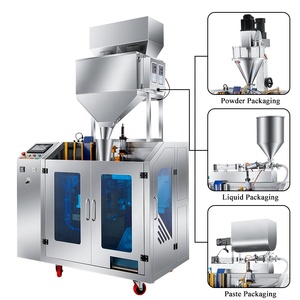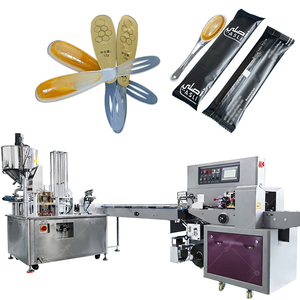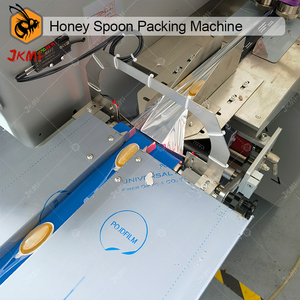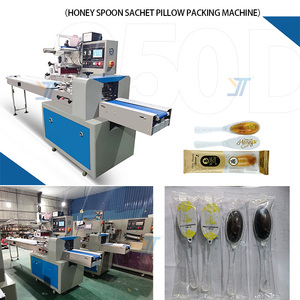
All categories
Featured selections
Trade Assurance
Buyer Central
Help Center
Get the app
Become a supplier

(1685 products available)



























A honey packer is a crucial piece of equipment for packaging honey. There are different types of honey packers for specific needs and requirements.
Pint canning line
An example of a honey pint packer is the Pint Honey Canner Packaging Line. This pint canning packaging line utilizes an electric turntable to present jars to the filling head. A jar of honey is lowered on the honey filling nozzle. Once filled, the jar is raised, and the jar is capped and labeled automatically. The pint canning packer is easy to operate and is designed for standard pint-sized jars of honey.
Bulk bin honey packager
Some beekeeping operations sell honey in bulk, such as 44-gallon drums or larger bins. Industrial filling machines can fill these bulk bins with honey at high speeds, meeting the demands of large-scale customers. Additionally, the bins are easy for customers to handle and store. The filling process is usually done through nozzle-based systems that ensure accurate and efficient filling.
Waterfall honey packager
The waterfall packer is commonly used for liquid to semi-solid products. The waterfall feeding mechanism gives an accurate weight/volume of honey. It works by dispensing product from a height onto a moving conveyor belt, which then carries the honey onto the scale to show weight, thus triggering the dispensation of another honey onto the moving conveyor. The honey waterfall packager is made from stainless steel and complies with food safety standards. Some of its features are a 20-1000 pounds weighing system and a touch control system with preset for product select, feed speed, alarm, and more.
Drip tray honey packager
This type of honey packager is perfect for filling jars or containers that are not already pre-filled. It is set up to catch drips after filling is accomplished. A collection pan is placed in front of the filler spout to catch drips during the filling process. This helps to ensure little to no honey is spilt and that the entire packaging process is as clean as possible.
Honey barcode labeler
This labeling packager is perfect for custom labeling. The honey product is labeled, and if necessary, the barcode is put on according to customer specifications. Labeling on this kind of honey packager is usually fast, accurate, and efficient.
Packaging Speed:
This refers to the speed at which the honey packer fills containers. Packaging speed is expressed in pouches per hour or pouches per minute. These can range from 20-120 pouches per minute.
Package Sizes:
Honey packers can handle different kinds of package sizes. Some may only be able to handle packaging sizes of a maximum of 12 ounces and a minimum of 5-10 pounds. Others can handle pouches anywhere from 5 ounces to 64 ounces or 1 gallon.
Weight Measurement:
This refers to the number of measurements the machine can handle. Some machines can handle anything from a 5-ounce honey jar to a 12-ounce honey jar based on a customer’s specific request to market demands.
Components:
What the honey packer consists of, including the feeder, conveyor belt, filling nozzles, touch screen interface, and scaling system.
Product Compatibility:
Capacity, dimensions, and design are some of the features that determine whether a honey packer will be compatible with different types of products. For instance, viscous liquids such as honey, shampoos, and motor oil may require an encapsulation machine with a specialized nozzle or filling mechanism that ensures accurate and efficient packing. Products like granulated sugar or flour will require a different filling system, weighing mechanism, and conveyer belt system altogether.
Material:
Honey packers are usually made from stainless steel, aluminum, and polymers. Stainless steel is used for machine components that require extra strength and durability, such as the conveyor belt or frame. Aluminum is lightweight and corrosion-resistant and is commonly used for honey packer components that need modularity and versatility. On the other hand, stainless steel is chosen for components that need to be cleaned and sanitized frequently. These include the filling nozzles, hoppers, and nozzles.
Automation:
Some machines have entirely manual packaging processes. Others can have as many as five main automation features, including weighing and measurement, filling, sealing, labeling, and sorting and stacking.
Cleaning:
Regular cleaning is an important part of the operation and maintenance process.
Honey Packaging machines may come with a specific cleaning schedule and instructions that users should carefully read and follow. It's standard to use a mild product and warm water for the cleaning task.
Honey packers generally feature a feature that makes it easy and fast to clean the entire machine. Some machines have a unique cleaning system in the shape of a trolley.
Lubrication:
Parts that move often need to be lubricated to keep the honey packer running smoothly and reliably, reducing wear and tear.
It may be a good idea to occasionally inspect the honey packer's wear parts to see if they need replacement. This helps to prevent breakdowns and ensure the smooth operation of the encapsulation machine.
Calibrating:
Many automated honey packers have weighing and measurement systems built into them. Ensuring these are properly calibrated means accurate packaging, minimal waste, and more efficiency.
Small-scale and artisanal beekeepers use manual honey packers. These packers give their products a distinct and organic feel. Beekeepers can use them to fill jars right away for farmers' markets or local sales. On the other hand, large-scale commercial beekeepers use automatic honey packers. These machines help with the high-volume packing of beeswax products. Automatic packers are rapid, precise, and cut labor expenses, making them perfect for bigger operations.
Honey packers with different filling heads allow for the packing of a wide range of container sizes and forms, from little jars to large containers.
The crimping machine in the honey packer system is designed to close foil or plastic wraps under caps. Crimping is a reliable method of securing a jar under a cap. The crimping machine is very useful in honey packing because it secures the product and provides a selling point with an unopened jar.
Honey packers also have labeling machines that can apply any type of label to the container, whether it be a front, back, or side label. The label can be applied in any format with the use of a honey packing machine. The labels are often applied in a straight line as well as wrapped around the container. Labeling machines can be used not just for labeling honey containers but can also be used for labeling any kind of packaging.
Determine the honey packager capacity required:
When selecting a honey packer, it's crucial to assess the packaging speed and volume. This determination directly correlates with the capacity of the honey packager needed. Beekeepers and honey producers should carefully consider their production rates and the quantity of honey they need to package per hour or day. It's essential to choose a honey packer that can handle the anticipated packaging volume to ensure efficient operation and avoid bottlenecks in the packaging process.
Select the appropriate packaging size and type:
It's essential to consider the packaging size and kind required for the business. Different honey packers are designed to accommodate various packaging sizes, such as jars, bottles, or containers. Additionally, the packaging type, including plastic, glass, or eco-friendly materials, is crucial to meeting customer preferences and market demands. Ensuring that the honey packer can handle the desired packaging sizes and types is vital for maintaining product quality and customer satisfaction.
Evaluate the accuracy and precision of the honey packing machine:
When selecting a honey packer, it's essential to prioritize machines with high weighing accuracy and filling precision. These attributes ensure consistent honey quantities per package, bolstering customer confidence and satisfaction. Honey is a valuable product, and customers expect to receive exactly what they pay for. Moreover, precise packing minimizes the risk of product waste and packaging errors, benefiting businesses by streamlining operations and enhancing cost-effectiveness.
Consider the design and functionality of the honey packaging machine:
The honey packer's ease of use, cleaning, and maintenance are critical factors to consider when deciding. Selecting a packer that offers straightforward operation, efficient cleaning processes, and minimal maintenance requirements contributes to smooth production workflows and reduced downtime. Moreover, prioritizing hygienic design elements is essential for preserving honey's quality and preventing contamination. Such designs facilitate proper sanitation practices and help uphold the product's integrity throughout the packaging process.
Q1: What is a honey packer used for?
A1: A honey packer is used to pack honey in different types and sizes of containers according to market demand. It can be used for manual, semi-automatic, or fully automatic packing.
Q2: What are the trends in honey packers?
A2: The trend is toward semi-automatic and fully automatic honey packers because they can increase efficiency. Moreover, multifunctional packing machines are popular as they can pack different types of products with minimal alteration.
Q3: How does a flow honey packer work?
A3: The flow honey packer works by controlling the flow rate of honey with a filler nozzle. It is designed for high-speed packing.
Q4: What are the features of a honey packer?
A4: The honey packer has different features according to its type. Generally speaking, it is equipped with filling, sealing, and capping functions. Some models have automatic, anti-drip, and multi-bottles functions.
Q5: What kinds of containers can honey packers handle?
A5: Honey packers can handle various containers according to business requirements, including glass jars, plastic bottles, tubes, and sachets.